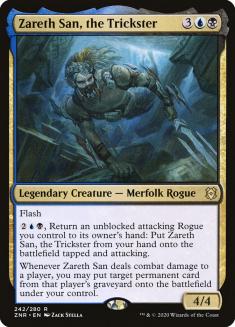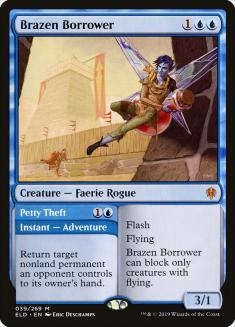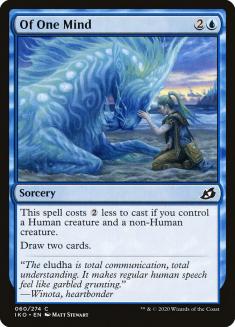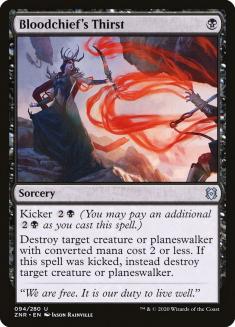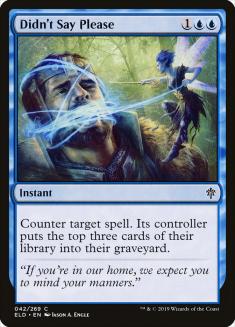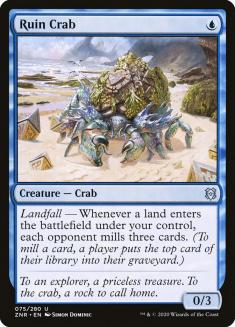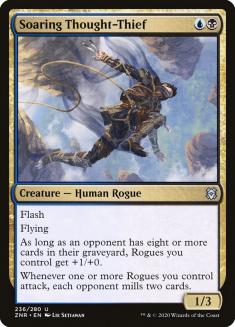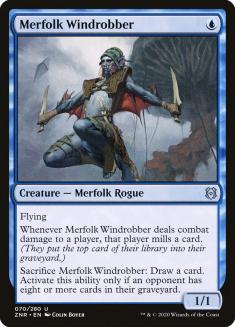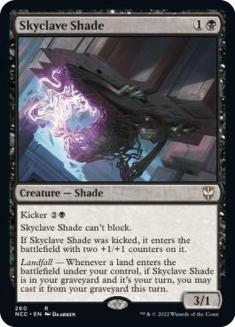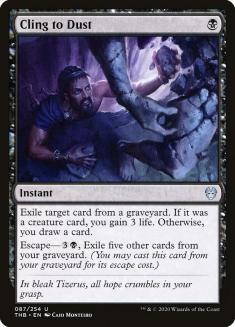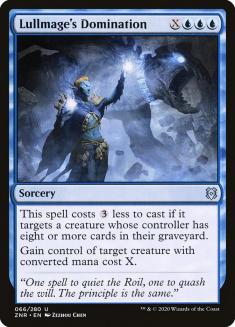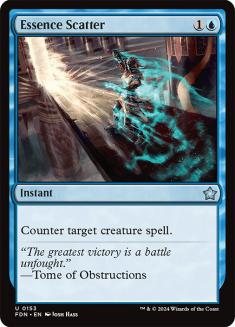Zendikar Rising Standard right now is a very balanced format; there are several Tier 1 decks and the ones that are Tier 2 are not far behind. On top of that, matchups are rarely polarized and things are even across the board — you can tweak any deck to be slightly better against any other deck but it will never be a slaughter. Because of this, I’m not going to tell you that you should play Dimir Rogues, only that, if you want to play Dimir Rogues, it’s a totally viable option, as are Gruul Adventures, Mono-Green Food, Dimir Control, Esper Doom Foretold, Temur Adventures and so on.
That said, Dimir Rogues was my weapon of choice for last weekend’s Zendikar Rising Championship, and it would be my choice if I had a tournament next week as well. Here’s the list I played to a ninth place:
Creatures (15)
Lands (22)
Spells (23)

This list has some particularities, so let’s talk about them:
Regardless of what else is in your deck, most Dimir Rogues lists can be split between lists with Lurrus of the Dream-Den and without. Obviously the card is powerful, so if you can play it you will, but there are three cards that you have to give up to do so — Shark Typhoon; Zareth San, the Trickster; and Brazen Borrower.
My opinion is that Lurrus is better than all these cards. They aren’t bad exactly, and Zareth San in particular can be quite good versus the green decks, but it’s very hard to compete with a card that you never have to draw to be able to play. Zareth San is sort of a plan of its own; the game turns into a mini-game on whether you can connect with it one or two times but it doesn’t really help the rest of your deck whereas Lurrus potentializes your mill plan and your Agadeem’s Awakenings. In any matchup where you’re trying to mill them out of the game Lurrus is a very strong card, and I think milling them out should be your priority against many of the top decks in the format.
Most people think of Of One Mind as a Limited card, but it’s actually quite good in Dimir Rogues, and the main difference between our list and other peoples. It’s good for a couple of reasons:
- The deck plays eight cheap Humans (the Rogues) and seven cheap non-Humans (Merfolk Windrobber and Ruin Crab), which means it’s not hard to make Of One Mind cost one mana very early in the game.
- The deck is overall quite cheap, so even when you don’t manage to make it discounted, you’re still not terribly upset by having to cast Divination a lot of the time, since you can just follow it up with two or three spells in the next turn.
- You want access to more types of cards without necessarily having to have them when they’re bad. For example, you could add two removal spells, but they would be horrible versus control decks; you could add two Didn’t Say Please, but they would be bad versus aggro decks. With Of One Mind, you find these cards more often, on top of finding your key cards Drown in the Loch and Into the Story more often as well.
I don’t think Of One Mind is some incredible piece of technology that you must play to succeed with Dimir Rogues, but I don’t like how my deck looks when I just jam a bunch of removal spells or a bunch of counterspells, so I think it’s a good compromise.
Keep in mind that having Of One Mind in your deck can often change the way you sequence your early turns. For example, if you have Thieves’ Guild Enforcer and Merfolk Windrobber, the natural sequence is to play the Enforcer first, to mill more cards; however, if you have Of One Mind in your deck, it might be interesting to play the Windrobber first, so that you can play both the Enforcer and the draw spell on Turn 2 (whereas you would be constrained on blue mana with the other sequence).
I think you want four removal spells and you want them to be a mix of Heartless Act and Bloodchief’s Thirst — I’ve liked two of each. Some teammates played Eliminate but I don’t think that’s good right now — there are too many expensive creatures you might want to kill (Questing Beast, Terror of the Peaks, Yorion, the Sky Nomad, Wicked Wolf, Feasting Troll-King) and I think that’s more important than killing Vivien, Monster’s Advocate tokens and powered up Scavenging Oozes.
I found that the fact that I only had Drown in the Loch as a counter for noncreatures was a bit exploitable — my opponents would often know when they could resolve a specific spell based on the size of their graveyard. Having one Didn’t Say Please isn’t much, but you see a lot of cards with this deck and it can help keep them in check a bit.
How to Play Dimir Rogues
As I’ve written before, Dimir Rogues is one of the hardest decks to play in recent memory. This is mostly because all your cards are cheap, so you always have many possible lines of play available to you, including just playing nothing. Most decks can’t afford to not play their three-drop on Turn 3 because they have a four-mana card they have to play on Turn 4 and a five-mana card to play on Turn 5, but Dimir Rogues can simply play nothing on Turns 2 and 3 and then play everything on Turn 4, for example.
The deck also requires you to make a decision as to whether you’re going to win by milling or by damage. Sometimes it’s irrelevant which one you choose, as you’re going to invariably win by either method. In other times, however, you can get punished for not picking your win condition early enough and whether you’re trying to win by damage or milling will influence the order you cast your spells or whether you cast them at all. This is especially true in sideboarded games, where milling people can often be a detriment.
Imagine, for example, a scenario where you have a Soaring Thought-Thief and you need to decide whether you’re playing it before or after you attack. If all you care about is the damage, then you should attack and then play the Thought-Thief, so you don’t risk milling two escape cards (or unnecessarily fueling cards like Elspeth Conquers Death or Dance of the Manse). If the milling is going to be relevant, then you have to play the Thought-Thief first. Once you make this decision, however, you can’t go back on it — if you attack and then play Thought-Thief and then you decide later on that, actually, you’re going to win by milling, this is two mills you’re never getting back. Similarly, if you play it precombat and mill their Chainweb Aracnir, you can’t all of a sudden decide you want to win by damage.
Because of this, it pays off to know very early on what your win condition is going to be. Obviously sometimes it has to change throughout the game (for example, you could be trying to kill them with damage and then they resolve The Great Henge or you could be trying to win by milling and they play Midnight Clock) and each game is going to be completely different from the other (sometimes you get that triple Thieves’ Guild Enforcer draw and all bets are off), but as a very general rule, I would say you should be looking to:
Mill them if they are:
- The mirror Game 1
- Mono-Green Food, Games 1 and 2
- Temur Adventures, Games 1 and 2
- Gruul Adventures Game 1
- Any control deck with 60 cards
Kill them with damage if they are:
- The mirror after sideboarding
- Gruul Adventures after sideboarding
- Any deck with 80 cards
The Matchups
Dimir Rogues occupies a weird position in the metagame because it’s not scared of any deck in particular, but at the same time it can be scared of every deck. Archetypes don’t beat Dimir Rogues; what beats Dimir Rogues are sideboard cards. In this regard, it’s similar to a deck like Dredge — you don’t care what they’re playing, you only care about whether they have Leyline of the Void or not. Any deck in Zendikar Rising Standard can be built to be better or worse against Dimir Rogues and its matchups fluctuate as a result.
Take, for example, Gruul Adventures. I’ve played versus Gruul decks with maindeck Ox of Agonas or with a sideboard plan consisting of three Ox of Agonas, two Phoenix of Ash, four Scorching Dragonfire and some number of Fire Prophecies — these felt like bad matchups. I’ve also played versus Gruul decks with four The Akroan War in the maindeck, or three Embereth Shieldbreakers, or that only had access to two Ox of Agonas and two Fire Prophecies in the 75 — these felt like good matchups. Similarly, I’ve played versus Esper Doom Foretold decks that felt easy and Esper Doom Foretold decks that felt hard. The difference between Dimir Rogues and Dredge is that Dimir Rogues can still beat even the most hateful versions and can still lose to the least hateful ones — its matchups are not nearly as polarized. Gruul, for example, can be a 45% or a 55% matchup. In this regard, it’s not different from the rest of the Standard format.
VS Gruul Adventures
As mentioned, Gruul Adventures is a matchup that can be favorable of unfavorable depending on their version, but in Game 1 you’re usually favored regardless of what they do because your cards are so much cheaper and they don’t have a lot of disruption. I found that I kill them most often by milling, but it’s overall a pretty even split.
The card you need to pay the most attention to is Bonecrusher Giant. If they pass Turn 2 with mana up, I often avoid playing creatures into it. Scorching Dragonfire and Fire Prophecy aren’t as bad, so you can commit Soaring Thought-Thief or Ruin Crab, but don’t give them the chance to play a “free” Stomp if you can help it.
Out:
In:
After sideboarding, things can get much tougher for you (or only a little tougher depending on their version) because they get so many removal spells and tools to grind you out. In my experience, your best plan is to try to kill them quickly, since your deck is cheap and their draws can be clunky, since it’s hard to grind through Ox of Agonas.
It’s hard to have an exact sideboarding, since it changes from version to version, but most Gruul decks will have between three and five escape cards and more removal, which makes decking them harder. Because of this, I often try to win Game 2 with damage. Originally I was sideboarding out all Ruin Crabs, since I wasn’t trying to mill them out, but I was having trouble consistently turning on Into the Story and Lullmage’s Domination, so I’ve been keeping two. If you play against a hypothetical Gruul player without any escape cards, or with maybe two escape cards and only a couple of Fire Prophecies, then you can consider keeping in all Crabs, for example.
Negate might be a weird addition since aggressive Gruul decks are not traditionally the decks you want Negate against, but it happens to be quite good versus them because you’re very interested in countering Vivien, Monster’s Advocate and their removal. Playing a Turn 3 Thieves’ Guild Enforcer and Negating their Stomp is a great turn, for example. You can also sometimes counter Heart’s Desire with it.
VS Dimir Rogues
The Lurrus version is favored in the Dimir Rogues mirror because it’s a good card that happens to be free and whatever it is they’re playing instead of Lurrus doesn’t really matter. If they don’t play Ruin Crab, then you’re very favored because most cards just trade back and forth so the game usually comes down to decking. In this matchup, you need to pay particular attention to what you have milled and what they have milled, as both players often get to single-digit library sizes and you need to know if it’s worth casting something like an Into the Story, for example, or just holding it back.
Out:
In:
Sideboarding here can also depend on which version they’re playing — for example, if they have four Brazen Borrowers, I don’t think you should have any Lullmage’s Dominations in your deck.
After sideboarding, the game changes radically; it’s no longer about decking each other but about killing each other with Skyclave Shade. If a person doesn’t have Skyclave Shade in their sideboard they will find it very hard to win a sideboarded game in this matchup. Because Shade is so important, milling them can often be a detriment, which is why the Crabs come out.
Some people in our team didn’t like Cling to Dust in the mirror, since the sideboarded games are much more fast-paced, but I think having a card that you can cast from your graveyard is too valuable, even if you don’t do it that often. Besides, I think you end up having to kill or counter Skyclave Shade quite a bit and then exiling it can be good. I might not include Cling to Dust in my sideboard just for this matchup but if I have it there, I’m always bringing it in.
VS Mono-Green Food
This is the most puzzling of all matchups because most pro players I talk to think this matchup is favorable for Dimir Rogues whereas public data always has Dimir Rogues as a very big loser. Personally, I think Dimir Rogues is favored versus Mono-Green Food and I would not play the deck if I didn’t think so.
The reason you’re favored is that your primary plan — milling them — simply trumps everything else that is happening. They have very few ways of killing a creature and they aren’t very fast (their strength is their resiliency). However, if you’re decking them, then they don’t have to be resilient — they have to be fast or disruptive and they can’t do either of these things very well. Trail of Crumbs and The Great Henge are very powerful cards if the opponent is trying to deal with all your stuff, but Dimir Rogues isn’t trying to deal with all your stuff; it’s simply trying to stall the game for long enough to kill you. So, in this matchup, don’t try to obtain some absolute control or anything like that — just focus on surviving long enough to mill them out. Because of how the matchup plays out, the most threatening card by a lot is Vivien, Monster’s Advocate since that card actually pressures you quickly enough to outpace decking them.
Out:
In:
After sideboarding, not much changes other than that you have to be a bit careful about Chainweb Arachnir. I often try not to expose my Merfolk Windrobbers until I can sacrifice them.
A lot of people like to sideboard in Cling to Dust in this matchup, but I don’t think it’s very good because the baseline of the card is so bad versus them. They don’t fill their own graveyard or yours, so you might not even be able to cycle the card early on if you need to and it might be a very long time before you can escape it. Hitting a Feasting Troll-King that is being brought back can be good but you’re still not accomplishing much other than killing it, since the three life is almost irrelevant in the matchup (they attack in very big chunks), so the most common scenario is that it acts as a removal spell that only works specifically against a Troll that is being brought back from the graveyard or a Chainweb Arachnir, and I don’t think that’s good enough.
VS Esper Doom Foretold
I think this matchup is another one that can range from favorable to unfavorable depending on their list, but Game 1 is usually good for you. During the tournament I played versus William Jensem and he had two maindeck Mystical Disputes and two maindeck Negates, so I definitely fell behind, as the best card you have by a lot is Into the Story and resolving it is highly correlated with winning the game.
In general, I would say that you don’t need to rush in this matchup, as you’re capable of winning the long game as well by just exhausting them off resources while you grind them out with Into the Story and Lurrus.
Out:
In:
After sideboarding, things can get worse for you depending on the number of counterspells and Duresses that they have. Skyclave Shade can be excellent or bad depending on their version (if they have many copies of The Birth of Meletis, for example, it gets a lot worse), but I’ve found that it’s almost always going to be better than Ruin Crab and it keeps your creature count high for Of One Mind.
One thing that I’ve noticed is that, most of the time, I think it’s worth mainphasing Into the Story if it will get around their counterspells — you really want to resolve that card and they don’t have any super good ways of punishing you.
VS Dimir Control
This matchup is very similar to Esper Doom Foretold, except they have a lot more counterspells and fewer ways of impacting the battlefield, which results in it being worse for you in Game 1. Tapping out versus them early on is almost always free as there are very few ways of punishing you.
Out:
In:
Sideboarding here is better for you because Skyclave Shade is actively great versus them. Esper Doom Foretold decks can have more blockers (The Birth of Meletis, Omen of the Sun) and more exile effects (Glass Casket, Skyclave Apparition) but Dimir Control basically has to have Extinction Event (which you can often fight for) or a removal spell plus Cling to Dust.
VS Temur Adventures (Obosh)
This is also another good matchup and plays kinda similarly to Mono-Green Food because they simply cannot deal with your Ruin Crabs. Milling them out is the primary game-plan almost all the time. The difference is that, in Game 1, they have a card that can win them the game if resolved (Genesis Ultimatum), but in my experience it doesn’t even win the game all the time in this version.
Out:
In:
Lullmage’s Domination is not great in this matchup, since they have Mystical Dispute and Brazen Borrower. I’m not entirely sure what mix of Negates and Mystical Disputes you should have, to be honest — I’d expect them to take out some or all of their Genesis Ultimatums, but if they don’t then you might want more counterspells. Some people on our team took out Bloodchief’s Thirsts for two more counterspells, but I like having cheap answers to Edgewall Innkeeper, even if the card is subpar outside of that creature specifically. As usual, Vivien is the scariest card they can have.
Moving Forward
I don’t think I would change anything in the deck — it performed quite well for us and I like our plans in most matchups. If you like this style of deck, I definitely recommend picking Dimir Rogues up; it’s hard to play but very rewarding once you master it and I also think it’s relatively well-positioned in terms of how many hate cards people have in their sideboards, so this is a good moment for it as well.




